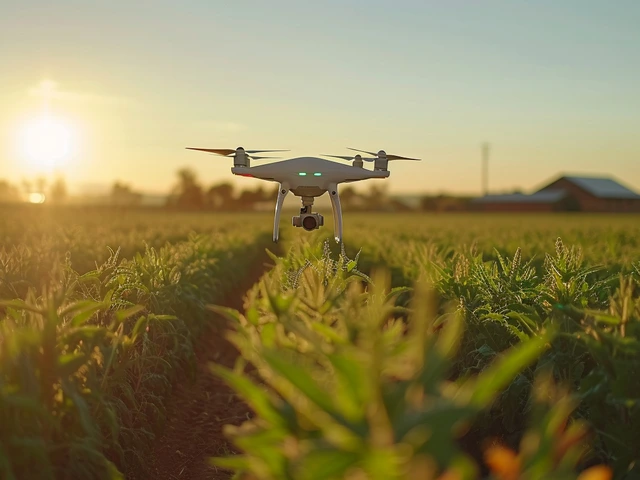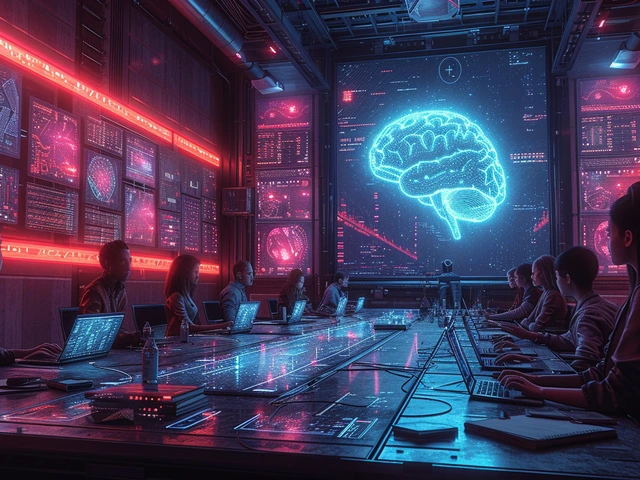Jan
21

- by Lillian Stanton
- 0 Comments
Why Python Reigns Supreme in AI
The synergy between Python and AI is undeniable. Coders and researchers often flock to Python for AI applications due to its simplicity and readability, which translate to quick iterations and deployments. What's more, the active community and plethora of libraries, such as TensorFlow and PyTorch, make Python a playground for AI enthusiasts. You might find me, on a regular afternoon, fixated on my screen, tinkering with neural networks, a bowl of snacks long forgotten on the desk, and my ever-present companion—a cup of coffee—gone cold. Meanwhile, Bolt happily dozes on the floor, unperturbed by the array of error messages that occasionally flash on the screen before finally giving way to a seamlessly executed piece of AI-driven code.
Community and Resources
Imagine standing in a never-ending library, filled with scrolls of knowledge on every AI topic under the sun. This is akin to the repository of Python resources available for AI enthusiasts. Active online forums and user-contributed code snippets add to Python's appeal. As novice programmers, we're not alone; there's always a seasoned developer in the community willing to help unravel the complexities of AI algorithms. My own learning curve was steep but buffered by countless tutorials, stack overflow discussions, and GitHub repositories. The accessibility of Python has allowed me to blend my creativity with structured logic to craft innovative AI solutions.
Libraries and Frameworks Tailored for AI
The plethora of libraries and frameworks that complement Python are akin to an artist's palette—essential instruments that bring AI to life. These tools, which include NumPy for numerical processing and Keras for neural networks, are the building blocks I use to transform creative ideas into working models. They provide me with an unparalleled flexibility and enable me to work on a variety of AI projects, from natural language processing to complex data analysis. With these resources at my fingertips, I can easily implement and experiment with advanced AI concepts.
Understanding Machine Learning with Python
I often find it fascinating how Python elegantly lends itself to the complexities of machine learning (ML). It allows us to create models capable of learning from data, improving over time. A dataset is to a machine learning model what a richly woven tale is to an eager reader—it is the foundation upon which understanding and intelligence are built. Whether we're dealing with supervised or unsupervised learning, Python's clear syntax makes the journey from concept to execution a smooth one. Under the warm glow of the lamp in my cozy Christchurch home, with Whiskers contently curled up on the windowsill, I explore the realms of predictive analytics and neural networks, often forgetting how quickly time slips by as I fine-tune my algorithms.
Supervised vs. Unsupervised Learning
Mastering the distinction between supervised and unsupervised learning is crucial. Broadly speaking, supervised learning involves teaching a model with labeled data, much like a child learning to recognize shapes and colors. Unsupervised learning, on the other hand, deals with unlabeled data, where the model learns to find patterns and relationships on its own, akin to solving a puzzle without a reference picture. Python's scikit-learn library is a powerful ally here, providing us with an array of tools to approach both types of learning. With datasets growing ever more complex, Python remains a beacon of hope for those of us delving into the uncharted territories of machine learning.
Key Machine Learning Algorithms
Algorithms are the heroes in machine learning tales. From decision trees that segregate data into branches like meticulous librarians, to neural networks that mimic the nuanced workings of our brain—each algorithm has a story and a specific purpose. It's a journey filled with trials, like achieving the delicate balance between bias and variance, or scaling mountains of data to find that perfect model fit. Python, an ever-faithful companion, simplifies interactions with these algorithms through its rich suite of libraries, allowing us to focus more on strategy and less on syntactical minutiae.
The Role of Deep Learning in Pushing AI Boundaries
Python's intimacy with deep learning is as profound as a composer’s connection with their masterpiece. This segment of AI mimics the human brain's ability to learn from vast amounts of data. It brings about innovations like image and speech recognition that once belonged to the realm of science fiction. The joy of watching a model you've built recognize objects or generate human-like text is indescribable. Within the walls of my home in Christchurch, as the gentle New Zealand breeze whispers through the open window, I'm not just a spectator of the future; I'm actively participating in molding it with Python and deep learning technologies like TensorFlow and Keras.
Frameworks Empowering Deep Learning
Python houses an array of frameworks specifically designed for deep learning. These frameworks—each with its own strengths and use cases—are like unique brushes for a painter. TensorFlow offers scalability and flexibility for research and production, enabling the translation of complex ideas into reality. Keras, with its user-friendly interface, allows for rapid prototyping, turning creative sparks into working models in record time. These tools empower us to push the boundaries of what machines can learn, and in my daily work, such frameworks are indispensable.
Practical Applications of Deep Learning
Deep learning has already revolutionized fields like medicine, where it aids in diagnosing diseases with frightening accuracy, or autonomous vehicles that promise to redefine transportation. These advancements are not just theoretical marvels; they are real, tangible demonstrations of what Python and deep learning can achieve together. Wading through complex datasets, tweaking layers and nodes, and the eureka moments that follow are part of my everyday reality. And the implications are immense—as AI continues to evolve, the scope of its influence can only grow, making this an exciting time to be at the intersection of Python and AI.
Integrating Python with Other Technologies
True innovation in AI rarely happens in isolation. As I delve deeper into my AI projects, I appreciate how Python plays well with others. It integrates smoothly with various databases, web frameworks, and even hardware interfaces. Sometimes, it feels like fitting together pieces of a complex jigsaw puzzle, each piece being a different technology that Python helps to bind seamlessly. This interoperability is crucial because it means AI solutions can be incorporated into a broader spectrum of applications, from intricate web services to robust Internet of Things (IoT) environments.
Data Science and Analytics Synergy
The relationship between Python and data science is particularly strong. Python's pandas library, for example, is a powerhouse for data manipulation, making it easier to clean, analyze, and visualize data—skills that are the backbone of any AI project. On cozy evenings, with the soft purr of Whiskers as she enjoys the warmth of my lap, I often find solace in the rhythmic patterns of data flowing through Python scripts. This synergistic bond between Python and analytics paves the way for deeper AI integrations and insights.
Emerging Trends in AI and Python
Keeping a finger on the pulse of emerging technology trends, I notice Python's role continuously evolving. Quantum computing, edge AI, and federated learning are some of the frontiers where Python is contributing to breakthroughs. The language's adaptability ensures that it remains at the crest of innovation, providing us with the tools to explore these novel realms. Being part of this journey feels akin to witnessing the dawn of a new technological era, with Python at the helm steering us into uncharted waters.
Getting Started with Python for AI
The first steps into the world of Python and AI can be intimidating but also exhilarating. The key is to start small, focusing on foundational concepts before diving into the deep end. My journey began with small scripts, basic algorithms, and an unrelenting curiosity. Bite-sized projects that tackle real-world problems can build confidence and proficiency. However, it's not all smooth sailing; errors and bugs are patient teachers, and with every mistake comes a lesson that carves out a better programmer in me.
Setting Up Your Python Environment
The right tools make all the difference when embarking on your Python AI journey. Setting up an environment with tools like Anaconda can simplify dependency management and package installations. It's a bit like preparing a gourmet meal—the prep work is crucial for success. Selecting the right editor or Integrated Development Environment (IDE) is personal. Some days I prefer the straightforward, no-frills approach of Sublime Text, while other times, the comprehensive features of PyCharm align better with the task at hand. What's important is finding a setup that feels right and empowers you to write efficient code.
Learning Resources and Community Support
Leveraging online courses, books, and community forums accelerates the learning process. Resources like Coursera, edX, and interactive platforms like Codecademy have been invaluable to me. They serve not only as knowledge bases but also as platforms for connecting with other learners and experts. Local meetups and hackathons have also been instrumental in expanding my network and knowledge. In the process, I've cultivated relationships with mentors and peers who've guided and inspired me, providing diverse perspectives that have shaped my approach to AI development.
Best Practices and Tips for Python AI Development
Developing the best practices over time helps keep my AI projects robust and scalable. Writing clean, well-documented code is essential. It's like leaving a map for anyone who might tread the same path after you, including your future self. Adhering to the principles of software development, such as version control with Git, has saved me from countless headaches. Regularly refactoring code ensures that projects remain manageable and efficient. Embracing testing has perhaps been one of the most crucial habits, allowing me to catch issues early and deploy AI systems with confidence.
Continuous Learning and Collaboration
The field of AI is continuously evolving, and so must we. Staying current with the latest tools, libraries, and best practices requires a commitment to continuous learning. Collaborative projects enhance this, as they provide exposure to different approaches and problem-solving techniques. I've found that the union of minds often leads to the most innovative AI solutions. Whether it's through pair programming or contributing to open-source, collaboration remains a key ingredient in my development as a Python AI practitioner.
The Ethical Dimension of AI Development
As a final note, it's essential to consider the ethical implications of AI. Responsible AI development must account for biases in datasets and the ramifications of automated decision-making. It's our duty as developers to ensure transparency, privacy, and fairness in AI systems. As I write code, I'm ever-aware of its potential impact on society, striving to make that impact a positive one. After all, at the heart of technology is humanity, and it's our empathy, our values, and our ethics that will shape the AI of tomorrow.






Write a comment